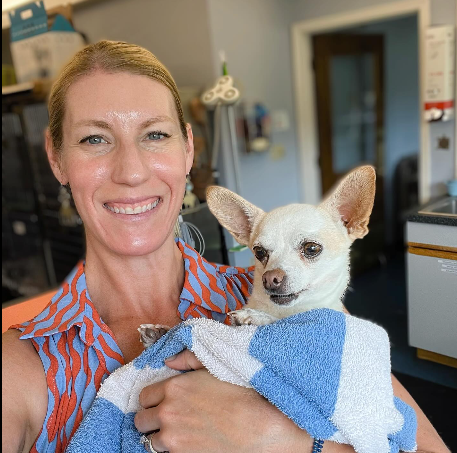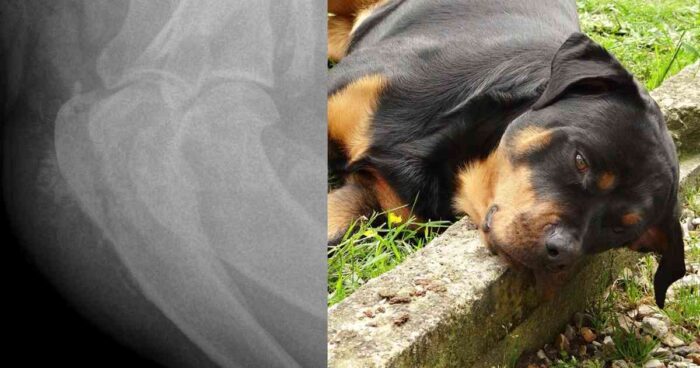Osteosarcoma is an aggressive type of bone cancer that can affect dogs, especially larger breeds like Rottweilers. This cancer typically starts in the long bones of the legs, but can also originate in other bones. Osteosarcoma is extremely serious if not caught and treated early. In this article we talk about Rottweiler Osteosarcoma-Bone Cancer Symptoms and Treatment.
Table of Contents
Symptoms of Osteosarcoma in Rottweilers
The most common early symptom of osteosarcoma in Rottweilers is lameness and swelling in one of the legs. This is often assumed to be a sprain or strain at first. However, the lameness persists and often worsens rapidly over the course of a few weeks to months.
Other symptoms include:
- Sudden onset of lameness that persists and worsens
- Swelling around the affected bone that gets progressively larger
- Pain, which may be intermittent at first then becomes constant
- Reluctance to exercise or play
- Lethargy and depression
- Weight loss and loss of appetite
- Fever in some dogs
If your Rottweiler displays these symptoms, especially lameness and a swelling that keeps getting larger, see your veterinarian right away for x-rays. Early detection and treatment is key with bone cancer.
Diagnosing Osteosarcoma
Diagnostic steps will include:
- Complete physical exam – palpating the swelling and checking for pain
- Imaging tests – At minimum two view x-rays of the affected leg, but often also chest x-rays. Advanced imaging such as CT scan, bone scan, or MRI may also be recommended.
- Biopsy – The only way to definitively diagnose bone cancer is with a biopsy. Either a fine needle aspirate or surgical biopsy will be taken of the tumor itself.
Staging Osteosarcoma
Once a diagnosis of osteosarcoma is made, the next step is tumor staging. This helps determine prognosis and the best treatment plan.
Stage 1 – The tumor is low grade, small, and has not yet spread to other areas. The prognosis is best with stage 1 tumors.
Stage 2 – The tumor is higher grade, larger, and may have minimal spreading to nearby lymph nodes.
Stage 3 – The tumor is poorly differentiated, large, and has spread to multiple local lymph nodes or the lungs. Prognosis is poorer in stage 3.
Stage 4 – The tumor is very aggressive, large, and has spread widely throughout the body. Stage 4 carries the worst prognosis.
Treatment Options for Osteosarcoma
Treatment almost always includes amputation of the affected limb, usually the front leg. Other options include:
Surgery:
- Limb amputation – Removes the tumor and prevents its spread. Dogs adapt well on 3 legs.
- Limb sparing surgery – Attempts to remove just the tumor while preserving the limb. Better for small tumors, but recurrence rate is higher.
Chemotherapy:
- Carboplatin or Cisplatin – Often combined with Doxorubicin. Helps kill remaining cancer cells after amputation. Improves survival time.
- Clinical trials – Experimental therapies may be an option through veterinary teaching hospitals
Radiation Therapy:
- Generally used for inoperable or metastatic tumors to shrink them and relieve pain.
Holistic & Alternative Medicine:
- Can be used alongside conventional treatment. Things like nutritional supplements, acupuncture, CBD oil, etc. Ask your vet.
The typical conventional protocol includes amputation of the affected limb followed by 4-5 months of intravenous chemotherapy. Just amputation alone only gives an average survival time of 4-6 months. Adding chemotherapy can increase survival time beyond a year.
Prognosis for Rottweilers with Osteosarcoma
The prognosis depends on how early the cancer is detected and the treatment plan. With aggressive, early treatment of amputation and chemotherapy, around 50% of dogs live beyond 1 year. About 20% will reach 2 years, and 10% live longer than 2 years.
Without any treatment, most dogs will be euthanized within 2-3 months of showing symptoms once the pain becomes unmanageable. Providing pain relief and using radiation therapy for palliative care can provide a few more good months.
The earlier osteosarcoma is diagnosed and treated, the better the chances are of extended survival. Performing routine physical exams and promptly having any lameness or swelling evaluated is key. Osteosarcoma is a very painful disease. Working closely with your veterinarian will provide the best quality of life for as long as possible. I sincerely hope you find this “Rottweiler Osteosarcoma-Bone Cancer Symptoms and Treatment” article helpful.

Dr. Allison Kramer is a seasoned veterinarian with a Master’s degree in Animal Behavior and over 10 years of experience specializing in canine health and behavior. Her expertise in positive reinforcement training and holistic care enhances the well-being of dogs and fosters strong pet-owner relationships. For expert advice and valuable insights, follow Dr. Kramer on Instagram @dr.allisonkramer.





